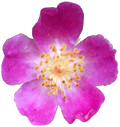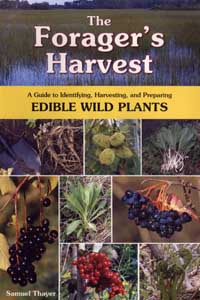The Milkweed Phenomenon
You Most Certainly Cannot Believe Everything You Read
By Sam Thayer
From The Forager. Volume 1, Issue 2. June-July 2001
The first time that I ate milkweed shoots, it was done with extreme care. I mean, extreme. I knew that the shoots were mildly poisonous when raw and that they would be terribly bitter and still a little toxic if not cooked properly. I knew that I had to boil them in several water changes, making sure that the shoots were covered with boiling instead of cold water - for the use of cold water would “set” the bitter principle in the vegetable. I also knew that this bitterness was caused by a toxic, milky latex. I knew all of this because I had read it in half a dozen books.
Not surprisingly, such elaborate and exacting preparation requirements, with such severe consequences if wrongly performed, caused me to put off trying milkweed for several years. When so many excellent wild vegetables exist, why waste my time with one that is described as “only marginally edible”? Or so I reasoned.
Nevertheless, one day in early May, responding to some insuppressible forager's curiosity, I brought home a handful of the thick, succulent shoots for a trial. I prepared them meticulously according to the instructions of my several books, then sampled hopefully. They were wonderful! I wanted to thank the genius who had discovered that such a common poisonous and distasteful plant could be made delectable through this special process. Over the few weeks that followed, I ate milkweed shoots on several occasions, and soon they became one of my favorite vegetables.
After a couple years I began to wonder if perhaps the three water changes that I had been using to cook milkweed parts were overkill, so I tried it with only two, still making sure to use boiling rather than cold water to refill the pot with each change. There was no perceivable difference in flavor. The next year I got even braver. All the warnings about terrible bitterness and mild toxicity notwithstanding, I changed the water only once when cooking my milkweed - again using boiling water as instructed. Still, there was no change in the flavor. That got me wondering, “Maybe milkweed isn't bitter at all? Maybe milkweed is not toxic when raw?”
Eventually I tried milkweed shoots boiled without changing the water; furthermore, I made sure to begin the process with very cold water so I could “set” this elusive bitter principle just to see what it tasted like. (I had expended so much time, water, and cooking fuel to fight this chemical culprit that I was becoming anxious to meet him.) The result was perfectly delicious without even a hint of bitterness. I drank of the cooking water, too, and it tasted mild and pleasant, like green beans. After that I went out and ate a small quantity of milkweed shoots raw, and they were rather tasty. So then I tried the milky sap by itself - only to find that it was without any noticeable unpleasant flavor. It turned out that our bitter enemy was too much of a coward to even show up.
This discovery begs the question: What is going on here? At that point in my life I already owned a small heap of wild food books, and every single one of them stated that milkweed was terribly and unpalatably bitter unless prepared according to precisely these same elaborate instructions.
I set out that year on a crusade to establish, beyond any reasonable doubt, that milkweed is not bitter. In May I gathered milkweed shoots from Ashland County, Wisconsin, cooked them without changing the water, and served them to nineteen people. None of them thought they were bitter. In early August I gathered pods from Pine County, Minnesota, which were served to more than twenty people - none of whom mentioned the word “bitter” in their descriptions of the flavor when asked. Smaller taste tests were conducted in Upper Michigan, far southern Wisconsin, and southeastern Nebraska. The milkweed was not bitter in any of these locations. There was no person involved in these samplings (of around sixty) who claimed to dislike the milkweed products. That is an amazing consensus for any food. More recently, two dishes containing once-boiled milkweed were served to about a hundred people at the 2000 Nature Wonder Wildfoods Weekend at Cairo, West Virginia. Not only were people quite pleased with these dishes, but one of the won the annual cooking contest. So I think the case has been made: milkweed is not bitter.
But wait! Were all those other authors lying? Telling fibs for the fun of it? I don't think so. Did they misidentify the plant? Probably not. Did they just copy one another, the whole myth originating with one author? Well, that has some truth in it; when one reads such adamant directions one is likely to follow them - as I did for several years - and nobody expects such precise instructions to be nonsense. Certainly many authors have repeated the elaborate milkweed preparation recipe and accompanying warnings without testing them, but the idea that milkweed is bitter must come from somewhere. Something strange is going on here, something I have come to call The Milkweed Phenomenon.
All of Euell Gibbons' writing was first-person - and he said that milkweed was bitter. Tom Brown and Steve Brill, both authors whom I am inclined to trust, also write of bitter milkweed. All of these wild food experts had their relevant experiences in the Northeast. I've never tasted milkweed in that part of the country, but when I talked to Dr. Peter Gail of Cleveland, Ohio, he insisted that in his area this vegetable, if not prepared properly, is terribly bitter, unpalatable, and even sometimes makes people sick. So I am under the impression that while the common milkweed Asclepias syriaca is perfectly edible in some parts of the Midwest, it tastes terrible in some parts of the Northeast unless carefully prepared. Precisely where the line of tension lies between these two extremes, I do not know. I'd appreciate feedback from readers on that.
The Milkweed Phenomenon, then, is when plants of the same species taste remarkably different in different geographic areas. It is important for us to keep in mind that this does indeed occur, for it helps to account for many of the discrepancies that one finds in print, or between literary sources and our own experience. I have many times tasted apples, both on the roadside and from grocery stores, which were terrible. If I thought that all apples tasted like that, I wouldn't recommend them to anyone, ever - but I know better. Apples are an incredibly useful and normally delicious food. Wild plants deserve to be judged by the same criteria and with the same expectations as our domestic crops are.
Dr. Elwood Fisher of Harrisonville, West Virginia, who knows more than a little about plant lore, told me on a walk through the Mountain State, “They say the nuts of the bitternut or yellowbud hickory are too bitter to eat, but I don't think they're all that bitter. They certainly aren't as good as shagbark hickory nuts, but they're not too bitter to eat.” That statement caught my attention, because here in northern Wisconsin, yellowbud hickory nuts are certainly too bitter to eat. They taste quite like fresh, unleached red or pin oak acorns, and I wouldn't eat them if I were starving because I think they'd just make me die faster. So I tried one of the West Virginia bitternuts, and indeed, it was a whole lot better than those found where I grew up - good enough that I could even eat one. On that walk we also collected some sumac berry heads to make rhus-ade. Although I have always been fond of sumac berries, the flavor of those in West Virginia (Rhus copallina) was something extraordinary compared to what I am accustomed to.
I collected two bushels of butternuts near Harrisonville, alongside the road, despite the fact that locals told me I'd have a hard time finding any. When I got them home and cracked a few, however, I was greatly disappointed, for these tasted more like black walnuts than butternuts to me. They were nothing like the mild, sweet, banana-vanilla flavored butternuts that I had gathered two weeks earlier in my home state.
Another example of the milkweed phenomenon which I remember vividly involved serviceberries (Amelanchier). While I certainly knew that these fruits varied considerably in their flavor, both within and between the several species, not until a few years ago while camping near Grayling, Michigan, had I ever encountered a truly bad serviceberry. On a morning walk I encountered several trees laden with plump, ripe fruit. Delighted, since I had not yet had breakfast, I shoved a handful into my mouth - only to spit it out moments later. I tried a few more, just to make sure that I hadn't imagined it. Then I tested several nearby trees. Still, the same repulsive and bitter flavor. Thus, while serviceberries remain among my absolute favorite fruits (see article in this issue), I am constrained to admit that at least sometimes they are far from choice.
Why does the milkweed phenomenon occur? It could have to do with regional variation in soil composition, at least in some instances. Many of the plants in question, however, occur over a wide range of soil conditions within each region. Milkweed, for example, is palatable in my area whether it occurs on alkaline loam, neutral clay, or acidic sand. Apparently, over the same range of sites it would be bitter in the Northeast, so soil composition cannot be the answer. A better explanation is something called introgression.
Introgression is the mixing of the genes of one species into the gene pool of another through hybridization. While animals can recognize and reject the members of other, similar species in sexual reproduction, plants have no such ability. Their pollen just goes wherever the wind or insects take it, and their sexual organs accept whatever suitable pollen is given to them. In other words, Ms. White Oak can't turn down Mr. Bur Oak just because she thinks he's ugly. Thus plants hybridize more frequently than animals do. While most hybrids are disadvantaged because they cannot compete successfully in the niche of either parent, in a few cases hybrids have a better chance of survival. In such cases one species may “absorb” genes from a relative through repeated hybridization and backcrossing.
The butternut blight does not kill black walnuts. Thus, since the introduction of the disease, butternuts which contain some black walnut genes are more likely to have survived than are those which do not. Since they have some black walnut parentage, they are also more likely to taste like black walnuts. This could very well be why the butternuts which still stand in West Virginia, where the disease has hit hard, taste much like black walnuts; and why the butternuts in northern Wisconsin, where the disease has not hit as hard and there are no black walnuts to cross with, taste “pure”. I have not been able to find any documentation that these two nut trees do indeed hybridize, but it seems likely, and this hypothesis fits the facts that we have.
I also suspect introgression in the case of the bitter milkweed, for most milkweeds besides the common species Asclepias syriaca are indeed very bitter. The area where bitter common milkweed is reported roughly coincides with the area where several similar milkweeds are also found: A. sullivanti, A. amplexicaulis, and A. purparescens. It seems that all or any of these species could contribute genes to the common milkweed's makeup, causing it to be bitter. None of these similar milkweeds is found where I live or where my taste tests were conducted. Again, this is only conjecture, but it makes perfect sense. Likewise, in northern Wisconsin, yellowbud is the only hickory, and therefore it cannot occur in hybrid form. In West Virginia, however, there are several more palatable species with which the yellowbud could hybridize. And serviceberries, the species of which are notoriously difficult to tell apart, are known to hybridize frequently and readily.
Whatever the reasons may be for particular instances of the milkweed phenomenon, it is important for us to keep in mind that it does in fact occur. Failure to recognize the regional variation in plant palatability has led to a great deal of confusion and not a little bit of anger. Those of us who are wild food instructors need to communicate with each other regarding our first-hand experiences in particular geographic locations, and those of us who are learning should not hesitate to report when our experiences differ from what we have heard or read. Do not assume that the book is right and you are wrong! It is possible for the book to be wrong, or for both of you to be correct regarding different regions. Today, a distrust of wild food literature is prevalent among the public, and with good reason. Only through effective communication can we change this - so let's start communicating effectively.
I am seventy-three years of age, having harvested and eaten Connecticut's wild milkweed shoots for over forty years. Milkweed from Connecticut is not the least bitter - so long as the shoots are harvested in early June - before the initial leaves unfold. If prepared after these little first leaves mature away from the stem - the product becomes bitter. Most interestingly, when properly harvested and cooked only once in boiling water for about as long as one cooks asparagus, the taste and texture is incredibly similar to asparagus! These delicacies must be watched carefully during early June - it is not easy to be there when the shoots first poke their heads above the ground - if you miss it by a day - you will be bitterly disappointed!
Little known: half the general population achieves a unique urine scent from eating cooked milkweed shoots - as is the case with asparagus. The other half of the population doesn't experience the scent. For the most part, nearly everyone in both population halves is not aware that the phenomena exists..or fails to exist.
--Richard (Dick) W. Hayward
Connecticut
Be sure to a look at Sam Thayer's book:
The Forager's Harvest: A Guide to Identifying, Harvesting, and Preparing Edible Wild Plants
Also be sure to see Botany in a Day: The Patterns Method of Plant Identification





 Wildflowers-and-Weeds.com
Wildflowers-and-Weeds.com 






